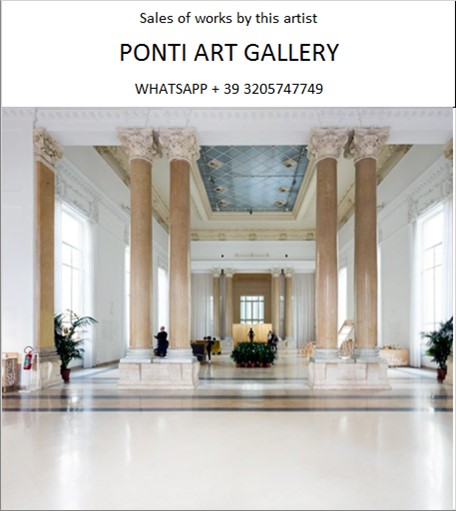Ponti Art Gallery is interested in buying and selling works
of art by this artist.

Giuseppe Terragni Biography
Giuseppe Terragni was an Italian architect whose work is widely regarded as a cornerstone of modernist architecture. Born on April 18, 1904, in Meda, Lombardy, Terragni was a pioneer in the Italian Rationalism movement, which sought to redefine architectural design through a focus on functionality and simplicity, eschewing the ornate styles that had previously dominated the European architectural landscape.
Terragni's early life was spent in the town of Como, where he attended the Technical College before pursuing higher education in architecture at the Politecnico di Milano. After graduating in 1926, he and his brother Attilio established an architectural practice in Como. This partnership would last until Giuseppe's untimely death in 1943.
The 1920s and 1930s were a period of intense creativity and innovation for Terragni. He became a founding member of Gruppo 7, a collective of architects who were instrumental in bringing the modern movement to Italy. This group, which later evolved into the Movimento Italiano per l'Architettura Razionale (MIAR), was opposed to the revivalist trends of the time and was inspired by the principles of Futurism and the work of international architects like Le Corbusier.
Terragni's architectural philosophy was deeply influenced by the political climate of his time, particularly the rise of Fascism in Italy. While his association with the Fascist regime has been a point of contention, it is undeniable that this relationship provided him with the opportunity to design some of his most famous works. His buildings from this era are characterized by their clean lines, geometric forms, and innovative use of space, which reflected the Rationalist ideals of clarity, logic, and order.
One of Terragni's most iconic projects is the Casa del Fascio in Como, constructed between 1932 and 1936. This building, which served as the local headquarters for the Fascist Party, is considered a masterpiece of modernist architecture. Its transparent facade and open interior atrium were revolutionary at the time and have since become emblematic of the Rationalist style.
Other significant works by Terragni include the Novocomum apartment complex (1927-1929), which was one of the first examples of Italian Rationalism, and the Sant'Elia Nursery School (1936-1937), which showcased his ability to create functional yet aesthetically pleasing educational spaces. His designs often featured a play of light and shadow, a careful balance between solid and void, and a thoughtful integration of buildings with their urban context.
Terragni's career was cut short by World War II. He was drafted into the Italian army in 1939 and served on the Eastern Front. The horrors of war took a toll on him, and after suffering a nervous breakdown, he was repatriated to Italy. Tragically, he died of a cerebral thrombosis on July 19, 1943, in Como, at the age of 39.
Despite his brief career, Terragni's legacy in the field of architecture is profound. His work has influenced generations of architects and continues to be studied and admired for its visionary approach to modern design. His commitment to a new aesthetic, coupled with a functional analysis of space and a pioneering use of materials like reinforced concrete, has cemented his place as one of the key figures in the development of modern architecture.
Terragni's impact extended beyond his built works. He was also a member of the "astrattisti comaschi," an artistic group that included Mario Radice and Manlio Rho, which played a significant role in Italian Modern Art. Furthermore, he contributed to the 1932 Exhibition of the Fascist Revolution, showcasing his engagement with the cultural and political discourse of his time.
In the years following his death, Terragni's work has been the subject of numerous exhibitions, critical studies, and retrospectives. His approach to design, which harmoniously blended modern theory with traditional Mediterranean elements, continues to inspire and challenge the architectural community. Giuseppe Terragni's contribution to architecture remains a testament to the power of innovation and the enduring relevance of Rationalist principles in the built environment.
Giuseppe Terragni Quotes and
Sales of Works
Ponti Art Gallery selects and deals with paintings by the
artist. Upon request, we provide free estimates and
evaluations, communicate prices, quotations, and current
market values.
If you are interested in BUYING or SELLING works by the
artist, contact us immediately.
If you wish to sell or receive an evaluation of the
works:
Send us a frontal photo of the painting, one of the back,
and one of the signature. Also, indicate the dimensions of
the work. Inform us about the purchase origin of the work
and any kind of available documentation (purchase
receipts, certificates of authenticity, publications). One
of our operators will respond to you on the same day. We
guarantee maximum confidentiality and extreme
professionalism.
If you wish to purchase works by the painter: Contact us
and let us know your request. We will inform you about the
available works. We also offer the possibility to
subscribe to our NEWSLETTER, through which you will be
informed at the beginning of each month about the latest
acquisitions of the art gallery.
You can send us pictures of the work:
